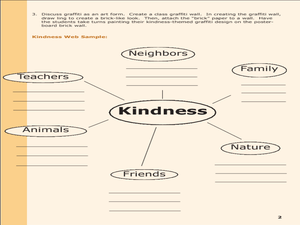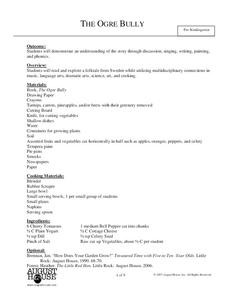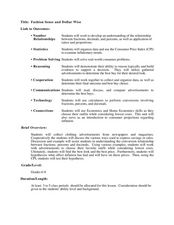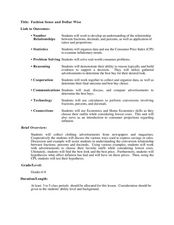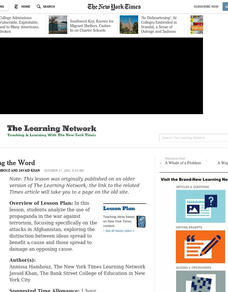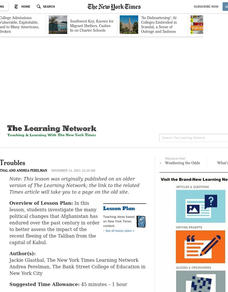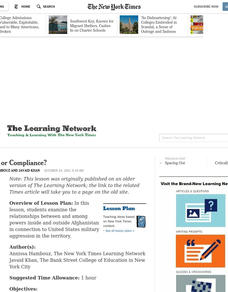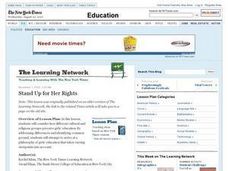Curated OER
The Electric Hearth
Students examine popular media. In this media awareness lesson, students keep logs of their interactions with media and then write an essay regarding the data.
Facing History and Ourselves
American Responses to the Armenian Genocide
Young scholars examine World War I war crimes. In this world history instructional activity, students use primary and secondary sources to research and understand the action taken by the United States during the Armenian Genocide. Young...
Curated OER
Kindness Graffiti Wall
Students discuss acts of kindness. In this character education lesson, students use a large sheet of poster paper, tempera paint, and markers to create a graffiti wall. Students write down their ideas of kindness and share their wall...
Curated OER
Depicting Motherhood in Family Stories
Learners explore triptychs. In this art history lesson, students define the terms "photograph" and "triptych". Learners discuss changes that occur between mothers and daughters and create an original triptych using...
Curated OER
The Ogre Bully
Students listen to the book, The Ogre Bully, and discuss the problems the farmer and his family had during the story. In this garden themed lesson plan, students examine different fruit and vegetables and plant them in soil to...
Curated OER
The Art of Jewelry
Young scholars discover Native American culture through jewelry. In this Native American culture lesson, students investigate several different Native American tribes and complete a word search activity. Young scholars create...
Curated OER
The Student Cafateria as the "Leafy Chestnut Tree"
Students examine the difference between "news" of earlier periods, and "news" as we know it today. They then go out into the school common areas and analyze news from the perspective of word-of-mouth storys and discuss what they can...
Curated OER
Teaching the Novel in Context
Students write a context paper. In this teaching the novel in context lesson, students view a primary sources to recreate the cultural and historical context of the novel. Students make the connection between the literary...
Curated OER
Colonial America Introduction
Students watch a teacher presented Readers Theater about Colonial America to introduce the students to the topic. In this Colonial America lesson, 4th graders recreate a timeline of early American history, using...
Curated OER
Fashion Sense and Dollar Wise
Young scholars work in groups to show understanding of the relationship between fractions, decimals, percentages, and the application of ratios and proportions. For this decimals, fractions, and percents lesson, students use real life...
Curated OER
Fashion Sense and Dollar Wise
Middle schoolers find the cost of an outfit. In this percentages lesson, students look at ads, pick out an outfit, and find the sale price. They create a commercial and complete 4 included worksheets.
Curated OER
Goldilocks and the Real Bears
Students participate in a comparison instructional activity where they compare fictional bears to real life bears. In this science/language arts instructional activity, students read Goldilocks and the Three...
Curated OER
Local Leaders
Second graders recognize the importance of having community leaders. In this community leaders lesson, 2nd graders find local leader names and local leader news items. Students answer questions and create a graphic organizer...
Curated OER
Spreading the Word
Young scholars analyze the use of propaganda in the war against terrorism, focusing specifically on the attacks in Afghanistan, exploring the distinction between ideas spread to benefit a cause and those spread to damage an opposing cause.
Curated OER
Kabul's Troubles
Students investigate the many political changes that Afghanistan has endured over the past century in order to better assess the impact of the recent fleeing of the Taliban from the capital of Kabul.
Curated OER
Alliance or Compliance?
Young scholars examine the relationships between and among powers inside and outside Afghanistan in connection to United States military aggression in the territory. They examine the interaction between the Northern Alliance, the...
Curated OER
Stand Up For Her Rights
Students consider how different cultural and religious groups perceive girls' education. By addressing differences and identifying common ground, students attempt to arrive at a philosophy of girls' education that takes varying...
Curated OER
The East Africa Times
Young scholars work in teams as editors to design the front page of a newspaper covering a country in east Africa. They individually research and write articles that define modern life for the country's citizens.
Curated OER
Taking to the Airwaves
Learners consider the purpose of talk radio and examine its importance in the new democratic Iraq. They enact mock talk shows based on current events and reflect on the value of free speech and the role audience members play in radio...
Curated OER
First Lady Fashions
Sixth graders research and explore the fashion of a certain time while identifying with the personal convictions and tastes of the famous first ladies of the past. They practice what they explore adjectives to describe what they see and...
Starfall
Oo is for Octopus
Oodles of fun and opportunities for learning are overwhelming in this Letter O activity series, which features printing practice for letters and numbers, connect the docts, and lots of cute octopi for your learners to color.
Curated OER
The Gettysburg Address (1863): Defining the American Union
Students explore the Gettysburg Address. In this U. S. history lesson, students examine Abraham Lincoln's speech and it's themes of freedom, equality, and emancipation.
Curated OER
Zimbabwe
Students explore the hardships being faced by the people in Zimbabwe. For this World History lesson, students research the challenges of Zimbabwe, such as hunger, poverty, low life expectancy and political controversy. Upon...
Curated OER
Cartoons for the Classroom: Ben Franklin's Cartoon Contribution
In this historical events worksheet, students analyze a political cartoon by Ben Franklin. Students respond to 3 talking point questions.


